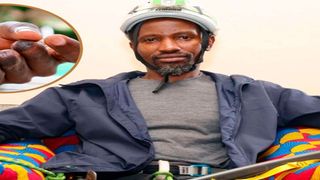
James Muhia, 41, is a father of two, a boy, aged 8, and a five-year-old girl. Inset: Muhia displays the fingers he lost from frostbite while on hike on the 6,812-metre Ama Dablam in Nepal.
| Bonface Bogita | Nation Media GroupLifestyle
Premium
Not even losing five fingers will stop him from scaling next mountain
What you need to know:
- James Muhia says recreational trail running, mountain running, hiking and ultra-running make his heart pulsate.
- Having conquered Manaslu in Nepal, Mr Muhia and his friend Mr Cheruiyot now have their sights trained on Everest.
One way of summing up James Muhia’s story is to say he likes torturing himself. Or how would you describe someone who gets five of his fingers partly amputated after an icy mountain climb-gone-wrong and decides not to stop hiking?
How else would you describe a man who decides to scale a mountain 8,000 metres high without carrying supplementary oxygen like most people do at such heights? What term would you give a person who once ran a 100-kilometre race in 19 hours in South Africa, once ran from Nairobi to Nakuru, and who has run up and down Mt Kilimanjaro in 15 hours?
What phrase would describe a man who took part in a challenge of climbing five mountains — Ruwenzori, Muhabura, Mount Kenya, Mount Meru, and Mount Kilimanjaro — in just seven days?
He calls it passion. He says recreational trail running, mountain running, hiking and ultra-running make his heart pulsate.
His family has come to accept his passion, but there is another way of interpreting this — they are not sure what to think of the 41-year-old father of two children aged 8 (a boy) and 5 (a girl).
“My mum tells me she is always praying for me every time I’m on the mountain,” says the Kiambu-born man who lives in Nakuru.
“(As for my wife), I think by this time she’s accepted that this is it and she’s supportive of my mountaineering stuff,” he adds.
He used to be just a University of Nairobi-trained businessman who sold spare parts; a man who played hockey in high school and in university but wasn’t all that sporty. This was until 2017 when someone convinced him to take part in a hike in eastern Kenya. The hike was to be in preparation for a hike on Mt Kenya.
That sparked the passion in him, a passion that has seen him go to Batian, the tricky uppermost part of Mt Kenya, numerous times. It has seen him spend millions of shillings to fly out of the country to scale mountains.
He has been From Uganda to Nepal to Kyrgyzstan to South Africa, he has toured the world powered by his spirit of adventure.
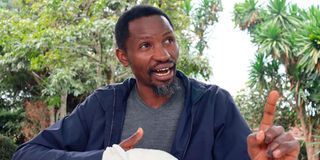
James Muhia gestures during the interview at Traventure café in Nairobi on November 18, 2023.
A typical hike starts by him doing an internet search. Names of mountains come up, plus the challenges. He then decides to go conquer that mountain.
That is how he found himself in Nepal in September this year, where he had a record-setting climb. So, what is this that keeps taking him from one mountain to another?
“No one has ever been able to answer that,” he says.
However, one word that features in many of his descriptions of hikes is “enjoy”. He finds the outdoors attractive. He loves the moments he spends out of mobile networks, just fully in the moment.
He also remembers an answer he once gave to someone who told him that to sustain his passion, he should endeavour to enjoy travelling, not just target to reach the peak.
“I said that so long as I enjoy climbing mountains, I will continue climbing mountains,” he says.
But that was in 2020, before he lost his fingers in a 2021 incident.
Despite the state of his hands, he has been up to the highest point Mt Kenya. He remembers his fingers bleeding because they had not fully recovered from a surgery.
He has also done another record-setting hike in Nepal. Now, he has two major mountains to go: Everest and K2. Everest (in Nepal and China) is the tallest mountain on earth while K2 (in Pakistan and China) is the second but more difficult to climb.
Some statistics say that for every four people that attempt to summit K2, at least one dies. Mr Muhia considers summiting K2 his ultimate challenge.
After James Kagambi beat him to the record of the first Kenyan to reach the Everest peak, he wants to go one better and be the first Kenyan to head there without using supplementary oxygen. His Everest hike is scheduled for April or May next year.
A summary of some of his hikes reveals what he is all about.
Mt Kenya (August 2017): the eye-opener
Mr Muhia says the fact that he was not taken to the highest point of Mt Kenya at his first hike of Africa’s second tallest mountain piqued his curiosity. After climbing smaller mountains in preparation, he was ready. By then, he did not know there were three peaks on Mt Kenya, and that Lenana, which they targeted, wasn’t the highest. When the organiser told him that the highest point is mostly accessed by foreign hikers, he promised himself to tackle it.
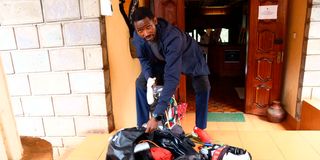
James Muhia begun mountain climbing in 2017 when someone convinced him to take part in a hike in eastern Kenya.
“So, I made it my point to climb Batian, to sort of prove a point,” he says.
From there, he sought training and started buying the safety equipment needed to go to the topmost point. He would finally go there in 2020, but after hiking some mountains outside Kenya.
Ruwenzori (2018)
Before going for the highest point of Mt Kenya, Mr Muhia headed to Uganda in June 2018 and hiked the Ruwenzori mountains. “I really enjoyed the ice, the glacier climbing, where you climb with these crampons and then you are roped together with the guides. And it was a very nice experience,” he recalls.
Lenin Peak (2018)
A month after going up the Ruwenzori mountains, Mr Muhia was in Kyrgyzstan in Central Asia. Lenin Peak is part of the Pamir Mountain Range.
“Lenin Peak is 7,134 metres high. Well, I really enjoyed the climb. I joined two French guys, two Russians, and two Swedish guys. So that was the group. There were seven of us with two guides. And out of the seven, I’m the only one who summited the mountain,” says Mr Muhia, and adds,
“I had not realised that at that point, but I was told I was the first Kenyan on record to climb a 7,000-metre peak and that cemented my love for the mountains. And the fact that out of the seven of us, I’m the only one who summited, it gave me a bit of encouragement. Plus, the 18 days were some of the most peaceful days I’ve ever spent,” he says, laughing.
Khan Tengri (2019)
Impressed by his achievements at Lenin Peak, he returned to Kyrgyzstan to summit another 7,000-metre peak — the Khan Tengri that is 7,010 metres high.
“It’s the most northern peak and it’s a very technical climb,” says Mr Muhia. It is during this climb that he met a group that made him look at his passion for hiking in a new light.
“I met a lot of people who’ve climbed mountains, and when they asked me what I’m doing there, the default answer was, ‘I’m preparing to climb Everest.’
‘And then, after Everest, what do you want to do?’
And I couldn’t answer, because my goal was Everest. So, as we talked, they were like, ‘No, I think you should concentrate on the journey to get there. Don’t just target Everest. There are people who’ve just targeted Everest, and then after Everest, they have this, like, mountaineer’s depression. Like you’ve been to the highest, and then there’s nothing for you anymore. So why don’t you pick some other challenges as you go towards Everest? You enjoy the climb.’
He says those words changed his perspective.
“I decided I’m not just climbing to summit Everest, but to enjoy the journey of climbing,” he says.
Ama Dablam (April 2021): the hike that took his fingers
Mr Muhia has three of his left hand fingers amputated at the topmost joint. Two on his right are also incomplete. This is thanks to his hike on the 6,812-metre Ama Dablam in Nepal.
“I researched some mountains and I settled on a technical mountain called Ama Dablam. It’s 6,812 metres, but is regarded by mountaineers as the most technical mountain in the Himalayas. A lot of people who’ve climbed Everest are unable to climb this mountain because of the technicalities. It’s basically a mix of ice climbing, rock climbing, and snow climbing. So, you have to have, you know, those three technical skills to summit the mountain. I set that challenge for myself, and in the spring, that’s April 2021, I went to Nepal,” he says.
“Approaching Ama Dablam, you use the same route people use to get to Everest. It’s only actually the last day that you part ways, because it’s only 12 kilometres from Everest,” he adds.
He fought with the weather and all and reached the summit at a point when everybody else had turned back. It was around 4pm when he reached the summit.
But he would not return to the next camp until many hours later. He was not far from dying. This was due to frozen ropes on the way down and the fact that he lost some of his key tools for manoeuvring the icy conditions. Due to an avalanche, the ropes had gathered ice.
Come 9pm, with no one near, he got stuck while dangling on a rope used to go up and down. Hanging through a harness on his waist, he was in such a way that he could move neither forwards nor backwards. Try being clever and you can fall and disappear.
“It’s very steep. You fall, you disappear, like in nothingness,” he says.
He considered dangling there until the next lot of hikers passed to save him. But once in a while, a cold gust of wind would run that would lower the temperatures.
“I knew that I couldn’t survive until morning. Probably, I would freeze to death. I later learnt that that night, it was negative 18 degrees on the mountain,” he recalls.
He feared he would die dangling. Then something changed.
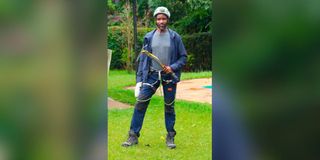
“I took out my phone. The idea was to record a video and, hopefully, if something happens (like death), someone will get the phone,” he says.
“When I was going to remove the phone, it came out with one of the photos of my daughter. Seeing that photo jolted me back to reality. Like, ‘You have to get that back down. I don’t know what you’re recording here. You need to get this time to get back down.’ I didn’t even record whatever I was trying to record. I just put it back and now tried to figure out a way out,” he remembers.
He then took a drastic decision: remove the outer protective gloves and remain with a thinner one to enable him to manipulate his hands better.
He managed to get himself out but it was at a price. The next morning, it was discovered that he had suffered frostbite. His hands were still and however much he tried to warm them, they could not respond.
He had to be evacuated by a helicopter, which was not possible because of the weather. It had to wait till the next day. In a hospital in Kathmandu, doctors told him there was nothing they could do until the fingers warmed.
Due to a fast-spreading Covid-19 variant, he had to return to Kenya with his hands looking pale purple and hardly responsive.
“I came back to Kenya, consulted further with doctors here. Most doctors I consulted with were very curious because they have never seen frostbite. It is after almost two months that I found a doctor who was willing to do a very delicate surgery to save the length of the fingers. Most of the doctors I consulted with were recommending amputation from (the first joint after the palm),” he says.
The plastic surgeon, Dr Adan Abdullahi, found a way of amputating the affected fingers at the second joint after the palm. He used skin grafts to cover the bone.
“It’s actually limiting. First of all, the grip is not as strong as before. And my descent, like when I’m upscaling, because I cannot grip the rope, it’s not very controlled. So, sometimes I have to use something we call a prusik to control my climb so that I don’t just fall down. It also limits my rock climbing because there are some technical moves that I may not be able to achieve, especially because the fingertips are very, very sensitive. So, I may need time to condition them or to learn to move differently,” he says.
Table Mountains (November 2021)
Here is a man who was just grappling with the loss of his fingers going to run 100 kilometres on the Table Mountains in South Africa.
“I completed the 100-kilometre race in 19 hours through those Table Mountains and all. It was a nice trail run but it took me 19 hours to complete, but I had to complete it. At some point, I thought of pulling out at kilometre 60 or 69 and I was like, ‘No; there’s a reason that I signed for this race. It is not to make time but to finish.’ And it was like a morale booster for me,” says Muhia.
Mt Kenya (January 2023)
This was the first time he was climbing a steep and cold mountain again after his surgery.
“I wanted to know that I can hold on to rocks in very low temperatures, very cold temperatures. I climbed up to Batian. By the time I was at the peak, the fingers were bleeding. They were painful, but I really wanted to see whether I can withstand the pain if it comes to that,” he says.
“To date, the fingers are very sensitive both to heat and to cold.”
Mt Kenya (June 2023)
He went to the highest point of Mt Kenya to see how his hands would respond.
“I realised that I’m learning to move differently on rocks, and it’s not the same way I used to climb. I have learnt to rely more on my foot grip than my hand grip,” he says.
Manaslu (September 2023): Hike that made him summon family
The desire to go up an 8,000-metre mountain was burning in him, and this time he had the company of Cheruiyot Kirui, another Kenyan who is wont to take up extreme challenges like the 100-kilometre race. The two decided to go to the summit of the 8,163-mentre-tall mountain in Nepal without a guide and without supplemental oxygen.
They did get to the summit against all odds, but it was not easy as both of them fell into crevasses at some point.
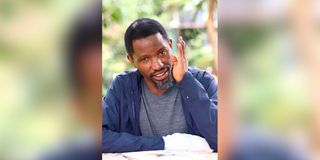
James Muhia gestures during the interview at Traventure café in Nairobi on November 18, 2023.
“By doing that climb, we actually became the first Africans to climb an 8,000-metre peak without using supplemental oxygen and without using shepherd support,” he says.
While heading there, he had to call his family to explain a few things.
“I was a bit open with them on the risks and, you know, told them that my intention is to come back but there is a real possibility that there are some things I can’t control. But I assured them that I would not put myself in unnecessary risks,” he says.
“I also carried two of my children’s toys and I promised them that I’d take photos with the toys on the mountain and make sure that the toys return to them,” he adds. He usually takes insurance to cover rescue and other eventualities.
Mt Everest (April/ May 2024): The next target
Having conquered Manaslu in Nepal, Mr Muhia and his friend Mr Cheruiyot now have their sights trained on Everest.
“We would want to do it from the China side because, much as it is tougher in terms of terrain, it has less objective risks like avalanches,” says Mr Muhia.
“The biggest challenge right now is of course these mountains are not cheap because like for the Manaslu, each one of us spent around $9,000, (approximately Sh1.4 million). For Everest, we would require like $45,000 each, (approximately Sh6.9 million),” he adds. “We are in the process of putting together a proposal and trying to get a few corporates interested.”
K2: The ultimate target
This is the mountain that is the grand prize in Mr Muhia’s world.
“If I was told that I have only one chance, of going K2 or Everest, I would go for K2. That is the bucket list climb. People who have climbed both mountains say they it is a different sport. Climbing K2 is completely different. It requires everything out of you. But we will see how that goes,” says Mr Muhia, and adds, “It’s the second highest mountain, but it’s the toughest mountain in the world to climb because of the weather, the terrain. It’s technical and very unpredictable,” he adds.





